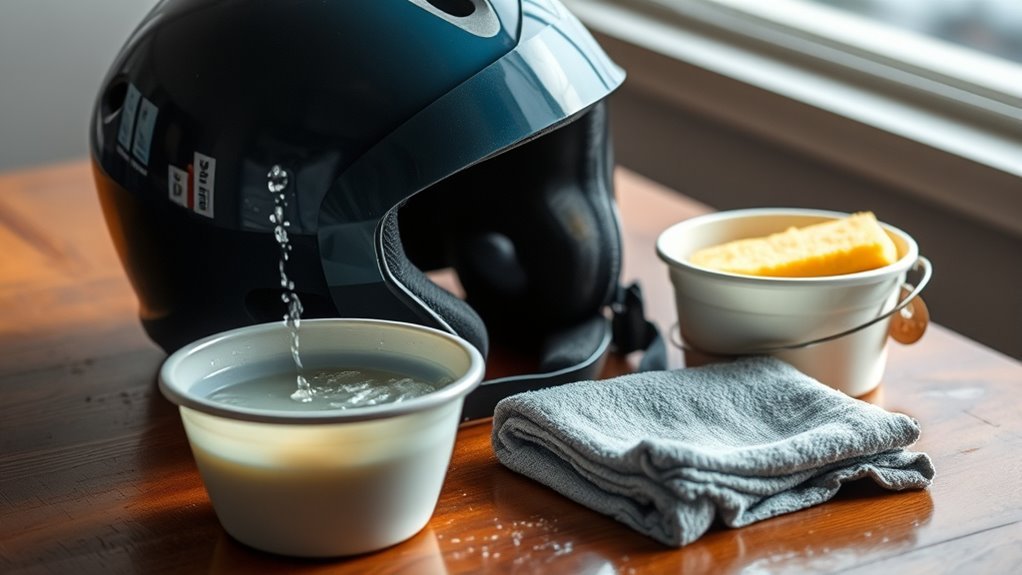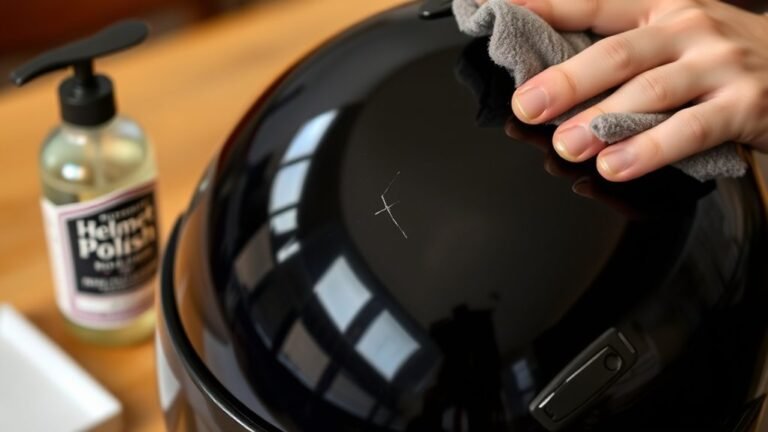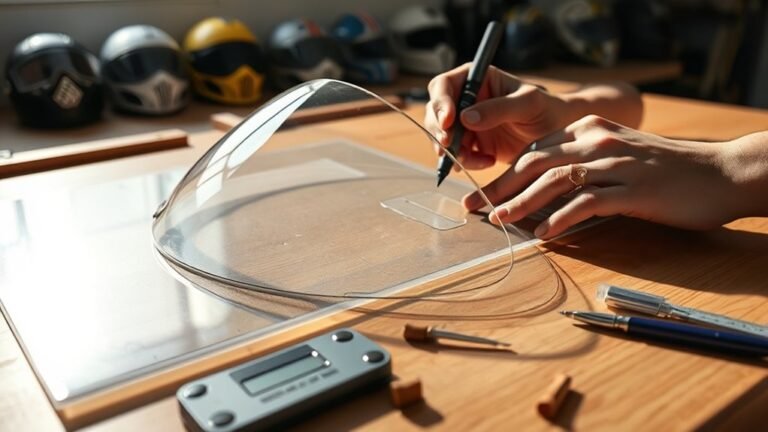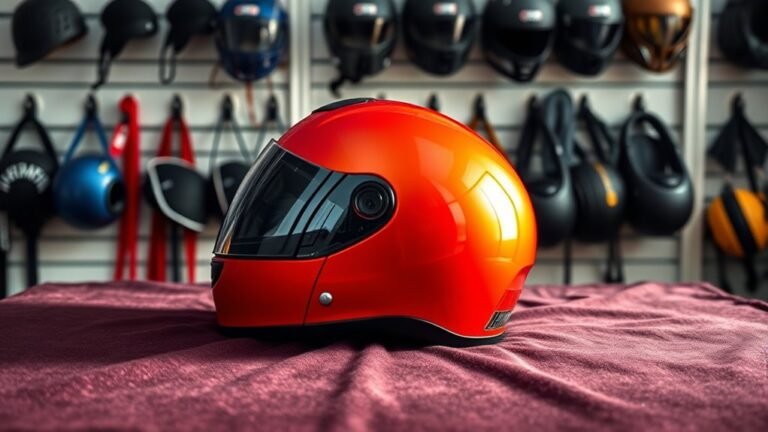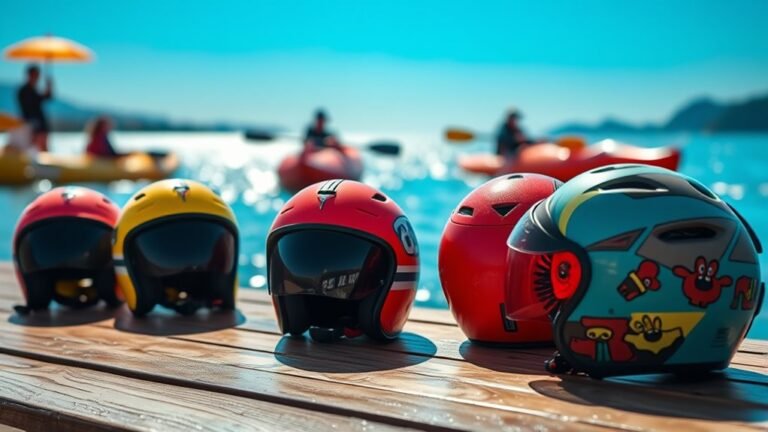How to Maintain Your Water Sports Helmet
To maintain your water sports helmet, inspect it regularly for cracks, dents, and worn padding. Clean the exterior with fresh water and mild soap, avoiding harsh chemicals. Check straps and buckles for functionality and adjust them for a snug fit. Store your helmet away from heat and sunlight, using a helmet bag to protect it. Be aware of signs that call for replacement, like discomfort or noticeable wear. You’ll find more tips on keeping your helmet in top shape.
Inspect Your Helmet Regularly
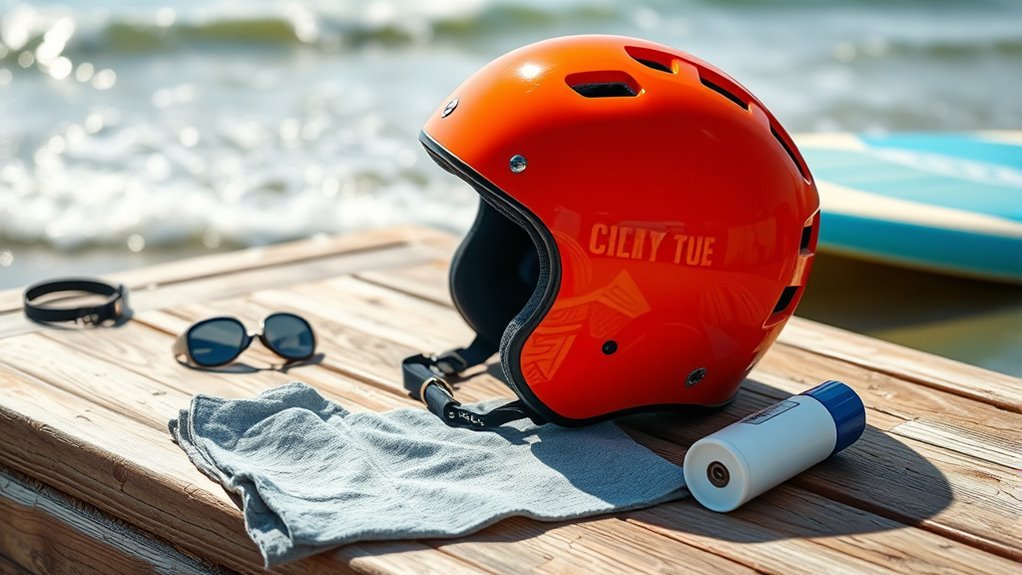
Although you might not notice any visible damage at first glance, inspecting your helmet regularly is crucial for your safety on the water. Start by using effective helmet inspection techniques: check the outer shell for cracks or dents, and examine the chin strap for fraying. Pay attention to the padding inside; it should be intact and secure. Look for signs of wear, like peeling or discoloration, which could indicate that the helmet’s protective qualities are compromised. Don’t forget to assess the fit; a loose helmet won’t protect you properly. By incorporating these practices into your routine, you’ll guarantee that your helmet remains reliable, allowing you to enjoy your water adventures with confidence and freedom. Stay safe out there!
Clean the Exterior
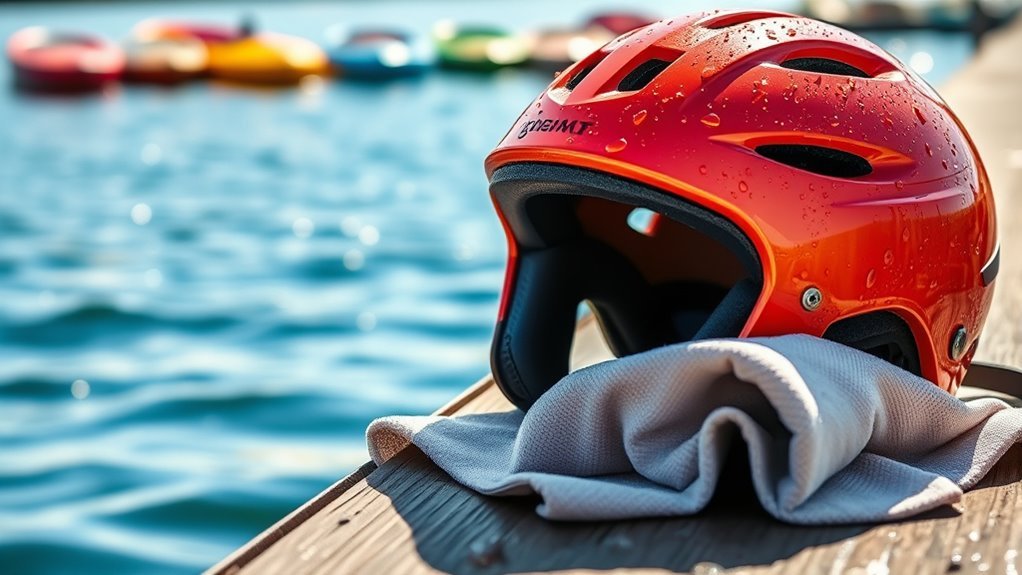
Cleaning the exterior of your water sports helmet is essential for maintaining both its appearance and functionality. Start by rinsing off any saltwater, mud, or debris with fresh water. For a more thorough clean, use gentle cleaning solutions specifically designed for helmets. Avoid harsh chemicals, as they can damage the materials. After applying the cleaning solution, scrub the surface with a soft cloth or sponge to remove stubborn grime. Rinse thoroughly to guarantee no residue is left behind. Once you’ve cleaned it, use proper drying techniques—like air drying in a shaded area—to prevent any moisture buildup that could lead to mold or damage. Keeping your helmet clean not only looks good but enhances your safety on the water.
Maintain the Interior Padding
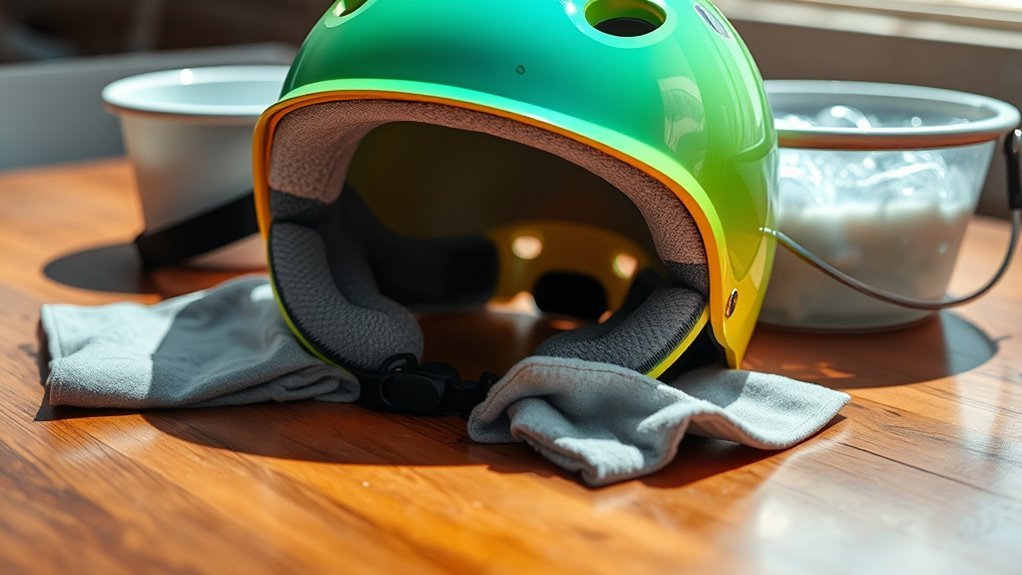
Maintaining the interior padding of your water sports helmet is vital for comfort and safety, especially since it directly affects how well the helmet fits and protects your head. Regular interior cleaning is important; use mild soap and water to wipe down the padding, making certain it remains fresh and odor-free. Check the padding for any signs of wear, and if you notice significant damage or compression, it’s time for a padding replacement.
| Task | Frequency | Notes |
|---|---|---|
| Interior Cleaning | After each use | Use mild soap and water |
| Inspect Padding | Monthly | Look for wear and tear |
| Padding Replacement | As needed | Confirm a snug fit |
Check the Straps and Buckles
Once you’ve guaranteed the interior padding is in good condition, the next step is to check the straps and buckles. Start by inspecting the straps for any fraying or wear; they should be strong and flexible. Make sure to make any necessary strap adjustments so that your helmet fits snugly without being uncomfortable. Next, look at the buckles; they need to be intact and functioning properly. Test their durability by ensuring they latch securely and release easily. A reliable helmet won’t just protect you; it’ll enhance your experience on the water. By regularly checking these components, you’re setting yourself up for freedom and adventure, knowing your gear is ready for whatever challenges you face.
Store Your Helmet Properly
To keep your water sports helmet in top condition, you need to store it properly. Always keep it away from heat sources, as excessive temperatures can warp the materials. Using a helmet bag can also protect your gear from scratches and dust, ensuring it stays ready for your next adventure.
Keep Away From Heat
While it might be tempting to leave your water sports helmet in a sunny spot after a day on the water, exposing it to heat can considerably compromise its integrity. Heat damage from prolonged exposure can lead to warping, weakening the materials and reducing the helmet’s protective capabilities. The thermal effects of high temperatures can also affect the foam lining, rendering it less effective in absorbing impacts. To keep your helmet in prime condition, store it in a cool, shaded area, away from direct sunlight. Avoid leaving it in a hot car or near heat sources. By taking these steps, you’ll guarantee your helmet remains reliable, allowing you to enjoy your water adventures with peace of mind.
Use a Helmet Bag
Using a helmet bag is one of the best ways to guarantee your water sports helmet stays in top shape. Helmet bag benefits include protection from scratches, dirt, and impacts, ensuring your helmet remains functional and safe. When choosing helmet bags, look for options with padded interiors and durable materials. A bag that fits snugly will prevent unnecessary movement and potential damage during transport.
Moreover, a helmet bag often features additional compartments for accessories, keeping everything organized and accessible. Investing in a quality helmet bag not only extends your helmet’s lifespan but also gives you peace of mind, allowing you to focus on enjoying your time on the water without worrying about helmet maintenance. So, gear up and protect your gear!
Avoid Exposing Your Helmet to Extreme Conditions
To keep your water sports helmet in top shape, you need to protect it from extreme temperatures and UV exposure. High heat or freezing conditions can weaken its structure, while prolonged sun exposure can cause fading and degradation. Always store your helmet in a cool, shaded area to guarantee its longevity and performance.
Temperature Extremes
Even if you’re careful with your gear, exposing your water sports helmet to extreme temperatures can compromise its integrity and safety. Temperature effects can weaken materials, leading to potential failure during use. To protect your helmet, consider these insulation techniques:
- Avoid direct sunlight: Store your helmet in a shaded area or indoors when not in use.
- Don’t leave it in your car: Extreme heat or cold can warp the structure and reduce effectiveness.
- Use protective cases: Invest in a case that offers insulation from temperature extremes while transporting your helmet.
UV Exposure Risks
While you might not think about it, UV exposure can seriously damage your water sports helmet over time. Just like your skin, your helmet needs sun protection to prevent UV damage. Prolonged exposure to sunlight can degrade the materials, making them brittle and less effective in protecting you during your water adventures. To keep your helmet in top shape, avoid leaving it out in the sun for extended periods. Instead, store it in a shaded area or use a cover when you’re not using it. Regularly check for signs of wear or fading, as these can indicate UV damage. By taking these simple steps, you’ll extend the life of your helmet and guarantee you stay safe while enjoying your favorite water sports.
Replace Worn or Damaged Parts
Regularly replacing worn or damaged parts of your water sports helmet is essential for guaranteeing ideal safety and performance. Neglecting this can compromise your helmet’s effectiveness, so it’s imperative to stay proactive. Focus on proper part selection and employ effective repair techniques to maintain your gear.
Here are three key components to check and replace as needed:
- Padding: Confirm the interior padding is intact and comfortable; replace it if it’s compressed or damaged.
- Straps: Inspect the chin straps for fraying or weakness; they’re critical for keeping your helmet secure.
- Visor: If your helmet has a visor, check for cracks or scratches that could impair visibility; replace it for clear sightlines.
Know When to Replace Your Helmet
Knowing when to replace your helmet is essential for maintaining safety during water sports. Helmets have a typical lifespan of about 3 to 5 years, depending on usage and exposure to elements. Even if you can’t see damage, wear and tear can compromise safety standards. If you’ve been involved in a significant impact or accident, it’s vital to replace your helmet immediately, as it may no longer provide adequate protection. Regularly inspect for cracks, dents, or any structural issues. Remember, your freedom on the water hinges on your safety gear’s reliability. Don’t push your luck—trust your instincts and prioritize your well-being by replacing your helmet when necessary. Staying safe means enjoying every exhilarating moment without worry.
Frequently Asked Questions
How Often Should I Replace My Water Sports Helmet?
You should replace your water sports helmet every three to five years, depending on its condition and usage. While a well-cared-for helmet can last longer, frequent exposure to water and impacts can compromise its integrity. Remember, a helmet’s lifespan isn’t just about age; it’s also about performance. If you notice any cracks or wear, don’t hesitate—your safety should always be your top priority. Enjoy your adventures, but make sure you’re protected!
Can I Use Regular Soap to Clean My Helmet?
Yes, you can use regular soap to clean your helmet, but be cautious. It’s best to opt for mild soap to avoid damaging the helmet’s materials. For a more effective clean, consider soap alternatives like vinegar or baking soda, which can break down grime without harsh chemicals. Always follow up with thorough rinsing and air drying. These cleaning tips will guarantee your helmet stays in top shape, letting you enjoy your water sports to the fullest.
What Materials Are Water Sports Helmets Typically Made Of?
Water sports helmets are typically made from materials like polycarbonate shells and impact resistant foam. Did you know that helmets can reduce the risk of head injury by up to 85%? This means having the right protection is essential for your safety while enjoying water activities. The polycarbonate shell offers durability, while the foam inside absorbs shocks. So, when you’re out there riding the waves, make sure your helmet’s built to keep you safe and free!
Is It Safe to Lend My Helmet to Someone Else?
It’s generally not safe to lend your helmet to someone else. Helmet care is essential for safety, and you can’t guarantee that the other person will treat it with the same care. Different head shapes and sizes can also affect the fit, impacting protection. Plus, if they’re involved in an accident, you could face liability concerns. Always prioritize your safety and the safety of others by keeping your gear personal.
How Do I Know if My Helmet Fits Properly?
Imagine your helmet as a trusted companion on an adventure. To guarantee it fits properly, start with a fit assessment: place the helmet on your head and adjust the straps. It should sit snugly, without pinching. Next, do a comfort check; move your head side to side and up and down. If it shifts or feels too tight, it’s time to find a better fit. A well-fitted helmet keeps you free to explore safely!
